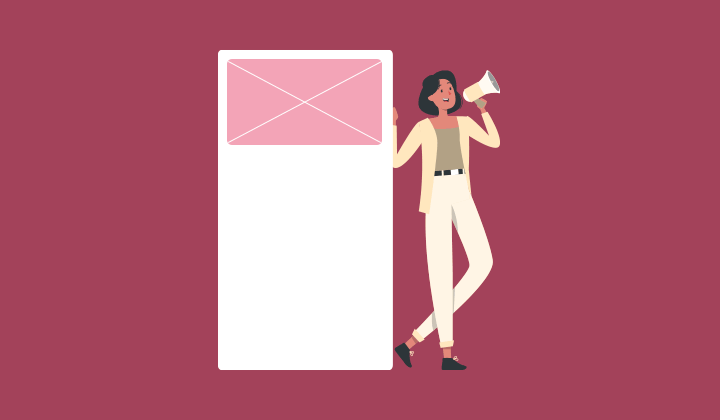Boring. Salesy. Easy to ignore. What other words come to mind when you think email newsletters?
The truth is, it doesn’t have to be that way. If you think that all newsletters are annoying, it’s likely because you haven’t stumbled upon the right ones. And you’re not the only one.
A report by the Content Marketing Institute revealed that three in four marketers integrate email newsletters into their content marketing strategy—yet only 40% of the people who use them find them critical to success. That’s because marketers tend to underestimate the potential of these regular emails and by neglecting them, can potentially lose business opportunities.
Thankfully, just about anyone can write thoughtful, engaging email newsletters. And, with the right tools, anyone can design one that captures attention and leaves people craving more.
So to get you on the path of readjusting how you see and create newsletters, here are seven tips to help you revamp your messages and engage your audience.
1. Don’t send an email newsletter just because everyone else does

Here’s the thing: newsletters are a tough sell. Plenty of inboxes are already overflowing with colorless emails that don’t add any value and push irrelevant sales. In fact, people receive so many unnecessary emails that they’re often discouraged from opening, let alone reading, much of anything. Chances are, you’ve deleted hundreds of newsletters without even opening them yourself—everyone does it.
When you send an email newsletter only to check off another activity in your content calendar, there should be little wonder as to why it doesn’t perform as well as your other marketing messages.
Author and book marketing executive MJ Rose says it better than anyone.
“One newsletter a year that is really interesting is more beneficial than 12 that are boring. If you write two or three boring newsletters in a row, your readers will start to think you write boring books.”
It’s excellent advice for publishers and marketers in any other industry. It doesn’t matter how often you send a newsletter, but how often your recipients open those newsletters and find interesting stuff to read.
The first rule to make your audience care about your content is avoid sending them just another email that follows the same overused newsletter templates and communicates nothing.
Your brand is different, so your newsletters should be, too. Schedule email newsletters in line with your strategy, not by following a competitor’s calendar or a one-size-fits-all non-strategy. You don’t have to send a specific number of emails per week or month to be successful.
Analyze your content calendar and identify how many high-value newsletters you can put together without draining your resources. One a month, one every two weeks or every three months, it doesn’t matter as long as it’s the best content you can deliver.
2. Stop calling them newsletters

It’s safe to say that no one enjoys having their inbox full of newsletters. So, the first reaction is always going to be “please, not another newsletter.” Overexposure alone has made the name woeful to most recipients.
Unfortunately, “newsletter” is no longer synonymous with valuable or entertaining, but rather seen as self-serving and annoying. Who would subscribe to and then open another email that generally gives useless information or discounts to products that no one buys?
So, besides revamping your newsletter, change your mindset to help your audience change theirs. You can start by finding a way to rename your newsletter, one that tells people right from the start why they should be on your email list and why they should open it.
You can call it a digest, report, snapshot, notes, news, advice, tips and tricks—anything that suggests the obvious value they’ll receive every time you hit the send button. For instance, investment firm Aegis Capital Management calls its newsletter “My Two Cents”. The website Amazing Ribs has named its email newsletter “Smoke Signals.” They’re regular newsletters, but wrapped differently, which makes them less likely to scare fans off.
To maximize your results, avoid using the word newsletter in your subject line. Instead of using “April Newsletter_Your Company’s Name,” start thinking outside the box. What’s in your email newsletter, and who might be interested in reading that and why?
The answer to these questions can be your next subject line. It’s not always about being different and clever or standing out at all costs. Simplicity and transparency often pay off, as long as you tell the reader what benefit comes from opening your newsletter—plus, it helps build trust that you’re delivering exactly what you say you are.
3. Structure your email list

People care about your newsletter when you start showing them that you care about your readers. So, whenever you craft content, make sure you do it with your target audience in mind.
At this point, you should focus on two principal activities: cleaning and segmenting your list.
If you want to see more engagement, you should first check out who you’re writing to. If half of your email list consists of fake addresses or addresses of people who have never opened an email from you, nothing you do will change that. Your metrics will continue to remain low, no matter how catchy your subject lines.
According to David Hoos, Director of Marketing at The Good, list hygiene is essential for launching successful marketing campaigns and keeping costs under control at the same time.
He explained in one of his articles: “Pruning a 50,000-member mailing list down to 10,000 members can save you several thousand dollars per year in unnecessary expenses and help convince the spam traps that you’re only mailing to people who want to hear what you say.”
Once you’ve selected the people you wish to communicate with, you can move on to segmentation: or dividing your email list into smaller groups using specific criteria. Neil Patel, for example, suggests using demographics, surveys, email engagement, past purchases, the amount spent, position in the sales funnel, website behavior, time since last purchase, or personal interests as possible indicators for effective segmentation.
By separating groups and sending them different emails, you offer a distinct message (sometimes wrapped in a different newsletter template) to a specific type of subscribers in your email list. It’s the sort of personalization that enables you to tap into personal interests and send email newsletters that resonate with people’s needs and feelings.
According to MailChimp, campaigns that use segmentation can get 14.37% more opens and 64.78% more clicks. That’s the result of making every recipient feel like you’ve written that piece only for them.
4. Create a re-engagement campaign

Re-engagement or win-back campaigns are a way to reactivate inactive subscribers on your list. Mostly common among e-commerce platforms, they could help you get in touch with a significant number of your old customers without being too pushy.
You, too, have received emails in which brands told you that they missed you or asked you if you were still interested in hearing from them. It’s an effective way to make people reconsider a brand by reminding them that they matter.
If you decide to go this way to win your audience back, you should focus on three critical elements of your email newsletter: the subject line, the content, and the call-to-action. Let’s take a closer look at each of these three items.
The subject line
In a re-engagement campaign, you need a powerful hook to convince the audience it’s finally the time to open your newsletter again. You can try to add the recipient’s name, for a change. “We miss you, Jane” is more likely to capture the attention than “We miss you.”
On the other hand, you could try to put all the attention on what the subscriber wants (“want” is a pretty powerful trigger, by the way!). For instance, the formula “Do you still want to hear from us?” makes recipients feel that they have complete control over your relationship.
The trick here is to look back at the sort of messages that your inactive subscribers used to open. Details like length, tone, and trigger words can help you identify patterns that work.
The content
Whether you plan to lure your prospects with special offers, welcome back discounts, or some exciting news about what you’ve done lately, make sure you make it memorable.
Your re-engagement email newsletter should read well and look good to convince people to take action. You should step out of your regular communication patterns, do some tests with easy newsletter templates, and, overall, reinvent yourself. Again, looking back to what people used to like about your previous newsletters might be an excellent starting point.
At the same time, you want to share a clear value proposition and add something new to the table. Right from the first sentence, show your audience the awesome things that they can expect from you from now on.
For starters, only make promises that you can keep and make sure that whatever you show in your newsletter is real and accessible on your website or your product. Tricking people is not going to convince them to care about you or your newsletter.
The call-to-action (CTA)
The purpose of this newsletter is to convince people to care about you once again. So, how do you know whether you’ve been successful or not? People will take action if you tell them what you want them to do and they do it.
Remember that you’re in quicksand, so you don’t want to go too far out there. For example, selling stuff is off-limits. At this point, you simply want them on board, even if they aren’t ready to commit.
The CTA could focus on offering a future discount, watching a video about your latest achievements, or confirming the fact they want to stay on your list.
5. Go the extra mile with a next-level newsletter design

According to Karan Sharma, a Digital Commerce expert and the Co-Founder at Kinex Media Inc, a newsletter can generate a better understanding of your business among potential customers.
“A newsletter can expand the horizons and give your audience a broader picture of who you are. Embedding helpful links and giving visual descriptions can attract more readers.”
Under this light, the way you design your newsletter becomes essential for convincing readers to care about your emails.
As part of your strategy to enhance your newsletter, you should consider experimenting with several newsletter templates to find one that is appealing to your audience. The hardest part at this point is balancing your brand voice with what your readers want.
That’s because you want your public to recognize you in your newsletters by your colors, logo, fonts, images, or other identifying elements. Luckily, most platforms and tools that enable you to create customizable emails have easy newsletter templates that can be adapted to reflect your brand.
A word on why you need a responsive newsletter
In the smartphone era, we shouldn’t even mention newsletter templates that aren’t responsive. According to HubSpot, 46 percent of all emails are opened on mobile devices, and 35 percent of business professionals read their emails on smartphones.
If you don’t use responsive email design for your newsletters, you risk losing multiple business opportunities—let alone part of your audience. And there’s more data surfacing every day to convince you to switch to responsive newsletter templates as soon as possible.
According to a 2016 study by Adestra, between 68 and 79 percent of people delete emails that don’t look good on mobile devices. Moreover, almost 29 percent of young smartphone users are likely to unsubscribe when emails display poorly. In plain English, if your newsletter template doesn’t look good on all devices, your audience won’t read your emails at all.
6. Track interactions

When you’re looking to improve the quality of your email newsletter, tracking interactions should become the norm. Data and analytics enable you to increase the performance of your email marketing campaigns in ways that otherwise would have remained unknown.
There’s little room for guessing at this point. And why should you rely exclusively on your gut when you can use tools that tell you how readers engage with your content or when you should follow up after an interaction?
According to HubSpot, email tracking can help both businesses and customers.
“With email tracking, businesses can navigate their inbox productively, communicate effectively, and ultimately build and maintain meaningful relationships. Customers can engage with emails without anticipating multiple follow-up emails or calls.”
It makes sense. You send the newsletter and, once the recipients receive it, you get to see how they interact with the content. You’ll know when they read your newsletter, how many times they come back to it, who takes action, and who deletes the email without even opening it. Not only can this data guide your future actions, but it can also help you create better, more engaging newsletters.
7. Encourage feedback

No one can tell you what your readers care about in a newsletter better than your recipients themselves. So, if you want highly-customized advice to improve your email newsletters, make yourself accessible to your readers.
Brendon Burchard, New York Times best-selling author, believes that it should be easy for customers to reply to a newsletter. He said: “I have to laugh when I receive newsletters from major personalities and when you hit reply, you get a 'do-not-reply' address. It's ridiculous! Don't you want your customers to reply to you?”
When you encourage feedback, people are more likely to engage with your content and start a conversation. For example, you can ask them what their favorite topics are or how often they wish to hear from you. You can also invite readers to evaluate your newsletter template or content and track changes in customer satisfaction over specific periods.
In time, you’ll do more than just make readers care about your newsletters. You get to build trust and consolidate relationships with your customers, which is the ultimate goal of any business or entrepreneur.
What’s next?
As you can see, all these tips have something in common: they help you create an email newsletter that is relevant and valuable to your recipients. While this type of communication has an obvious self-promotional purpose, you shouldn’t focus entirely on your brand when crafting content or choosing newsletter templates.
As with any other marketing technique, you need to send the right message, at the right time, to the right people. So, your newsletter should be educational or entertaining (or both), while promoting a product or service.
The key takeaway: You should value the people who receive your newsletter more than the email itself. Because when you care about your audience, the audience will care about you.



